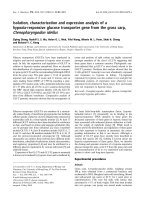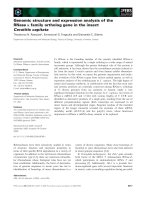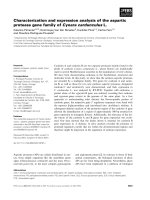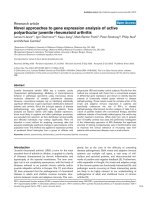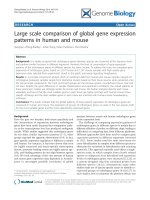Global gene expression analysis of cranial neural tubes in embryos of diabetic mice
Bạn đang xem bản rút gọn của tài liệu. Xem và tải ngay bản đầy đủ của tài liệu tại đây (3.8 MB, 225 trang )
GLOBAL GENE EXPRESSION ANALYSIS OF
CRANIAL NEURAL TUBES IN EMBRYOS OF
DIABETIC MICE
JIANG BORAN
NATIONAL UNIVERSITY OF SINGAPORE
2008
GLOBAL GENE EXPRESSION ANALYSIS OF
CRANIAL NEURAL TUBES IN EMBRYOS OF
DIABETIC MICE
JIANG BORAN
MBBS
A THESIS SUBMITTED FOR THE DEGREE OF
DOCTOR OF PHILOSOPHY
DEPARTMENT OF ANATOMY
YONG LOO LIN SCHOOL OF MEDICINE
NATIONAL UNIVERSITY OF SINGAPORE
2008
ACKNOWLEDGEMENTS
i
ACKNOWLEDGEMENTS
I would like to express my deepest appreciation to my supervisor, Associate
Professor S Thameem Dheen, Department of Anatomy, National University of
Singapore, for his innovative ideas, invaluable guidance and constant
encouragement throughout this study.
I am greatly indebted to Professor Ling Eng Ang, Head of Department of
Anatomy, National University of Singapore, for his full support in providing me
with the first class research facilities and an excellent academic environment, as
well as for his valuable suggestions to my career.
I am also thankful to Associate Professor Samuel Tay Sam Wah and Dr.
S Dinesh Kumar, Department of Anatomy, National University of Singapore, for
their kind suggestions and constructive criticisms.
I am happy to acknowledge my gratitude to Mrs Yong Eng Siang
(Neuroscience Lab), Mrs Ng Geok Lan (Histology Lab), Miss Chan Yee Gek
(Confocal Microscopy Lab), Mdm Wu Ya Jun (Electron Microscopy Unit), Mr
Yick Tuck Yong (Multimedia Unit), Mr Poon Zhung Wei (Autoclave Room),
and Mr Lim Beng Hock (Animal House) for their technical assistance and Mdm
Ang Lye Gek, Carolyne, Ms Teo Li Ching Violet and Mdm Diljit Kour for
their secretarial assistance.
ACKNOWLEDGEMENTS
ii
I would like to express my thanks to Miss Evelyn Loh Wan Ting for her
kind help and collaboration in the research.
I would like to extend my thanks to all staff members, my fellow graduate
students in Department of Anatomy, National University of Singapore for their
help and support one way or another.
I would like to express my special thanks to my friends, Dr Jayapal
Manikandan and Dr Peter Natesan Pushparaj at the Department of Physiology,
National University of Singapore for their friendly help and advice.
Certainly, without the financial support from the National University of
Singapore in terms of Research Scholarship and Research grant
(R-181-000-038-112 to Associate Professor S T Dheen), this work would not have
been brought to a reality.
I would like to express my heartfelt thanks to my parents for their full and
endless support for my study.
Finally, I would like to thank my wife, Mdm Yin Na, for her full support,
encouragement and assistance during my study.
ACKNOWLEDGEMENTS
iii
This thesis is dedicated to
my beloved family
TABLE OF CONTENTS
iv
1
2
2
3
5
6
7
7
9
10
11
12
12
13
CONTENTS
ACKNOWLEDGEMENTS………………………………………………… ………
TABLE OF CONTENTS…………………………
LIST OF ABBREVIATIONS…………………… …
SUMMARY…………………………………… ……………………………….……
PUBLICATIONS…………………………………………………………………….
Chapter 1: Introduction…………………………………………………… … ……
1. Diabetes Mellitus……………………………………………………………………
1.1. Definition and classifications of diabetes mellitus…………………………
1.2. The complications of diabetes mellitus………………………………………….
1.3. Maternal diabetes………………………………………………………… ……
1.3.1. Congenital malformations in embryos of diabetic mother………………
2. Neural tube development……………………………………………………………
2.1. Neurulation………………………………
2.1.1. Neural tube defects………………
2.2. Neurogenesis in the developing cranial neural tubes…………………………
2.2.1. Developmental control genes in the process of neurogenesis……………
2.2.1.1. Doublecortin (Dcx)……………………………………………
2.2.1.2. Brain lipid binding protein (Blbp)……… ………………………
2.2.1.3. Paired box gene 6 (Pax6)……………………………
i
iv
xi
xiii
xvii
TABLE OF CONTENTS
v
15
16
17
18
19
21
21
21
22
23
23
24
25
25
26
28
28
29
29
30
30
32
2.2.1.4. Neurogenin 2 (Ngn2)……………………………………………
2.3. Glucose metabolism and hypoxia in the developing cranial neural tubes………
2.3.1. Glycolysis pathway…………………………………………………….…
2.3.2. Hypoxia in the developing cranial neural tubes…………………….…….
2.3.2.1. Hypoxia-inducible factor 1 (Hif-1)………………………………
2.3.2.2. Vascular endothelial growth factor (Vegf)……………………….
2.4. Choroid plexus development…………………………………………………
2.4.1. Choroid plexus (CP)………………………………………………………
2.4.2. Development of CP in mouse embryos…………………………… ……
2.4.3. Factors involved in CP development…………………………… ……
2.4.3.1. Transthyretin (Ttr)……………………………………………….
2.4.3.2. Insulin-dependent growth factor 2 (Igf-2)…………………… …
3. Analysis of global gene expression profile using DNA microarray…………………
3.1. Overview of DNA microarray technology………………………………………
3.2. Basic principle of DNA microarray……………………………………… ……
3.3. Applications of DNA microarray………………………………………… ……
3.4. Data analysis strategies……………………………………………….………
4. Animal models…………………………………………………………….………
4.1. Animal models of diabetes mellitus…………………………………….………
4.1.1. Mechanism of action of streptozotocin (STZ)……………………………
4.2. Animal model of maternal diabetes…………………………………….………
5. Hypotheses and Objectives………………………………
TABLE OF CONTENTS
vi
35
37
38
40
41
41
42
42
43
44
44
45
49
49
51
52
52
54
54
55
57
5.1. Specific aims…………………………………………………………………….
Chapter 2: Materials and Methods………………………………………………….
1. Animals………………………………………………………………………………
2. Induction of diabetes mellitus………………………………………………………
2.1. Blood glucose test………………………………………………………………
2.2. Collection of embryos……………………………………………………… …
3. Histology…………………………………………………………………………….
3.1 Fixation of embryos……………………………………………………………
3.2. Preparation of silane coated slides………………………………………………
3.3. Cryosection of embryos…………………………………………………………
3.4. Haematoxylin and Eosin staining………………………………….……………
4. RNA extraction and quantification…………………………………………… ……
5. Microarray analysis…………………………………………………………………
5.1. Synthesis of double stranded cDNA from total RNA……………………………
5.2. cDNA cleanup and precipitation…………………………………………… …
5.3. Synthesis of Biotin-labeled cRNA………………………………………………
5.4. cRNA clean up and quantification……………………………………………
5.5. Fragmentation the cRNA for target preparation…………………………………
5.6. Target hybridization……………………………………………………………
5.7. Post-hybridization washing, staining and scanning of arrays……………… …
5.8. Data analysis……………………………………………………………… …
TABLE OF CONTENTS
vii
57
58
58
58
59
65
69
70
73
75
76
76
78
79
81
82
87
92
93
5.8.1. Absolute data analysis……………………………………………………
5.8.2. Comparison data analysis………………………………… ……………
5.8.3. Gene filtration………………………………………………………….…
5.8.4. Gene clustering and functional analysis based on Gene Ontology………
6. Real time reverse transcriptase polymerase chain reaction (Real time RT-PCR)…
7. Immunohistochemistry (IHC)…………………………………………………….…
8. Immunofluorescence staining…………………………………………………….…
9. BrdU labeling analysis………………………………………………………………
10. Terminal Deoxynucleotidyl Transferase -mediated dUTP Nick-End Labeling
analysis (TUNEL)………………………………………………………………….
11. In situ Hybridization………………………………………………… ……………
11.1. Plasmids for preparation of cRNA probes…………………………….………
11.2. Preparation of competent cells………………………………………………
11.3. Transformation of competent cells with plasmids……………………………
11.4. Linearization of the plasmid…………………………………………………
11.5. Synthesis of digoxigenin-labeled RNA probe from the linear DNA…………
11.6. Whole mount of in situ hybridization……………………………… ………
12. Western blot analysis…………………………………………………………….…
Chapter 3: Results……………………………………………………………………
1. Neural tube defects in embryos of diabetic mice……………………………………
2. Gene expression profile of cranial neural tubes in embryos of control
TABLE OF CONTENTS
viii
94
95
95
96
96
97
98
98
99
100
100
100
and diabetic mice……………………………………………………………………
3. Effect of maternal diabetes on expression of genes involved in glucose
metabolism and that respond to physiological hypoxia in cranial neural
tubes of mouse embryos…………………………………………………………….
3.1. Maternal diabetes altered the expression of genes involved in glycolysis in
cranial neural tubes of mouse embryos…………………………………………
3.2. Maternal diabetes altered the expression of genes that respond to hypoxia in
cranial neural tubes of mouse embryos…………………………………………
3.2.1. Expression of hypoxia-inducible factor 1α (Hif-1α) in cranial neural
tubes of embryos from control and diabetic mice………………………
3.2.2. Expression of Vegf in cranial neural tubes of embryos from control
and diabetic mice…………………………………………………………
4. Maternal diabetes induces apoptosis in the neuroepithelium of cranial neural
tubes in mouse embryos…
5. Maternal diabetes inhibits proliferation index in the neuroepithelium of cranial
neural tubes in mouse embryos………………………………………………… ….
6. Maternal diabetes alters the expression of genes involved in neuronal
migration and neurogenesis in cranial neural tubes of mouse embryos…………….
6.1. Expression pattern of developmental control genes is altered in
embryos of diabetic mice……………………………………………………
6.1.1. Paired box gene 6 (Pax6)………………………………………….……
6.1.2. Neurogenin 2 (Ngn2)……………………………………………………
TABLE OF CONTENTS
ix
101
101
102
103
103
104
105
106
108
110
112
115
118
6.2. Development of radial glial cell lineages and migration of neurons
are disrupted in the cranial neural tubes of embryos from diabetic mice……
6.2.1. Doublecortin (Dcx)…………………………………….……………
6.2.2. Brain lipid binding protein (Blbp)………………………………………
7. Development of choroid plexus is impaired in cranial neural tubes
of embryos from diabetic mice………………………………………….…………
7.1. Transthyretin (Ttr)……………………………………………….…………….
7.2. Insulin-like growth factor 2 (Igf-2)……………………… ………
7.3. The proliferation index in the choroid plexus and adjacent
neuroepithelia ………………………………………………….……………
Chapter 4: Discussion………………………………………………………………
1. Apoptotic cells are increased and mitotic index is decreased in cranial
neural tubes of embryos from diabetic mice………………………………………
2. Expression of genes involved in neuronal migration and differentiation
is altered in cranial neural tubes of embryos from diabetic mice……….…………
3. Expression of genes that are involved in glucose metabolism and that respond
to hypoxia is altered in cranial neural tubes of embryos from diabetic mice………
4. Development of choroid plexus is impaired in cranial neural tubes
of embryos from diabetic mice…………………………………………………….
Chapter 5: Conclusion…………………………………
TABLE OF CONTENTS
x
123
149
39
63
68
70
199
200
202
203
References…………………………………………………………………………….
Figures and Figure Legends…………………………………………………………
Tables:
Table 1……………………………………………………………………………………………
Table 2……………………………………………………………………………………………
Table 3……………………………………………………………………………………………
Table 4……………………………………………………………………………………………
Table 5……………………………………………………………………………………………
Table 6……………………………………………………………………………………………
Table 7……………………………………………………………………………………………
Table 8……………………………………………………………………………………………
LIST OF ABBREVIATIONS
LIST OF ABBREVIATIONS
1,3-BPG: 1,3-bisphosphoglycerate
2-PGA: 2-phosphoglycerate
3-PGA: 3-phosphoglycerate
ABC: Avidin-Biotin complex
ALD: aldolase
bHLH: basic helix-loop-helix
Blbp: brain lipid-binding protein
BNIP3: BCL2/adenovirus E1B 19 kDa interacting protein 3
BrdU: 5-bromo-2-deoxyuridine
CNS: central nervous system
CP: choroid plexus
CSF: cerebrospinal fluid
DAB: diaminobenzidine tetrahydrochloride
dc: diencephalon
Dcx: doublecortin
DEPC: Diethyl Pyrocarbonate
DHAP: dihydroxyacetone phosphate
DLHPs: dorsolateral hinge points
DM: diabetes mellitus
ENO: enolase
F-1,6-BP: fructose 1,6-bisphosphate
F-6-P: fructose 6-phosphate
FABP: fatty acid-binding protein
G-6-P: glucose 6-phosphate
GADP: glyceraldehyde 3-phosphate
GAPDH: glyceraldehyde-3-phosphate dehydrogenase
GPI: glucosephosphate isomerase
HCl: hydrochloric acid
Hif-1: Hypoxia-inducible factor 1
HK: hexokinase
IDDM: insulin-dependent diabetes mellitus
xi
LIST OF ABBREVIATIONS
Igf-2: insulin-like growth factor 2
LDH: lactate dehydrogenase
MAP: microtubule associated protein
MHP: the median hinge point
Ngn2: neurogenin 2
NIDDM: noninsulin-dependent diabetes mellitus
NTDs: neural tube closure defects
Pax6: paired box 6
PBS: phosphate-buffered saline
PCR: polymerase chain reaction
PEP: phosphoenolpyruvate
PFK: phosphofructokinase
PGK: phosphoglycerate kinase
PGM: phosphoglycerate mutase
PK: pyruvate kinase
PYR: pyruvate
rc: rhombencephalon
SDS: sodium dodecyl sulfate
STZ: streptozotocin
T
4
: thyroxine
TBS: Tris buffered saline
tc: telencephalon
TPI: triosephosphate isomerase
Ttr: transthyretin
TUNEL: Terminal Deoxynucleotidyl Transferase -mediated dUTP Nick-End Labeling
Vegf: vascular endothelial growth factor
xii
SUMMARY
SUMMARY
A high frequency of pregnancy complications including perinatal mortality and
congenital malformations such as neural tube anomalies has been shown in
women with diabetes mellitus. However, the underlying mechanisms contributing
to these malformations are not clear. The aim of this study was to investigate the
molecular and morphological changes in cranial neural tubes of embryos from
diabetic mice.
Morphological analysis revealed malformations in cranial neural tubes,
particularly in the telencephalon, diencephalon, and rhombencephalon as well as
the ventricular system of E11.5 embryos from diabetic mice. The neuroepithelia of
the forebrain and hindbrain and ventricles appeared to be distorted and fused. The
molecular changes were analyzed by oligonucleotide microarray which is a useful
tool to evaluate the expression patterns of thousands of genes involved in
morphogenesis, cellular functions as well as biochemical and metabolic pathways
in cranial neural tubes of embryos from diabetic mice. Overall, 1613 genes have
been found to be differentially expressed in cranial neural tubes of embryos from
diabetic mice. Among these genes, a total of 390 genes exhibiting greater than
2-fold changes has been placed into 8 main functional categories as follows: 1.
metabolism (27.7%); 2. cellular physiological process (20.3%); 3. cell
communication (12.1%); 4. morphogenesis (6.9%); 5. response to stimulus (3.8%);
6. cell death (2.3%); 7. cell differentiation (2.1%); 8. small subsets of genes
(5.4%).
xiii
SUMMARY
Further, the microarray analysis shows that several genes involving cell cycle
progression, migration and differentiation of neuronal and glial cells in cranial
neural tubes were differentially expressed in embryos of diabetic pregnancy. A
majority of those genes including doublecortin (Dcx), doublecortin-like kinase
(Dclk), brain lipid binding protein (Blbp), insulin-like growth factor-2 (Igf-2),
paired box gene 6 (Pax6), and Neurogenin 2 (Ngn 2) were downregulated in
embryos of diabetic pregnancy. In addition, maternal diabetes altered the cell
cycle progression in cranial neural tubes by regulating the expression of genes
involved in apoptosis and cell proliferation. These results indicate the disruption
of neuronal migration, neurogenesis as well as axonal wiring, which may
subsequently result in malformations in developing brains of embryos from
diabetic mice.
The neural tube malformation appears to be the result of multiple causes
including metabolic abnormalities caused by maternal diabetes. Genes involved in
pathways related to glucose metabolism and hypoxia have been found to be
altered in cranial neural tubes of embryos from diabetic pregnancy. Maternal
diabetes has been shown to induce excessive physiological hypoxia and oxidative
stress, contributing to severe pathological conditions in embryos. In the present
study, the maternal diabetes-induced physiological hypoxia appeared to have
triggered an adaptive response in the cranial neural tube by activating the
expression of several genes encoding enzymes involved in aerobic and anaerobic
glycolysis pathways. However the adaptive response seems to be insufficient to
xiv
SUMMARY
reverse the hypoxic state of the neural tissue in embryos from diabetic mice as
there was an upregulation of hypoxia-inducible factor-1α (Hif-1α) which is
activated under hypoxia and rapidly degraded in the presence of oxygen. The
upregulation of Hif-1α expression is harmful to the development of cranial neural
tubes in embryos of diabetic pregnancy as it has been shown to promote apoptosis
and cell growth arrest. Taken together, the altered expression of genes that
respond to hypoxia appears to be associated with cranial neural tube
malformations in embryos from diabetic mice.
In addition, maternal diabetes appears to impair the development of choroid
plexus (CP) and ventricular system in embryos. CP produces cerebrospinal fluid
(CSF) which determines the shape of the developing brain and transfers nutrients,
proteins and other molecules required for neuroepithelial cell survival as well as
proliferation and neurogenesis during brain development. The CP produces
several proteins including insulin-like growth factor 2 (Igf-2), which functions as
a morphogen in inducing differentiation of CP epithelial cells and transthyretin
(Ttr) which is involved in the transport of thyroxine and retinol, that regulate
neuronal differentiation in the developing brain. Malformation of the CP and the
ventricular systems together with reduced production of Ttr and Igf-2 in cranial
neural tubes of embryos from diabetic mice appear to influence the neuroepithelial
survival, proliferation and neurogenesis. It is possible that these changes may
impede further development of functional domains of the brain and subsequently
contribute to intellectual impairment in the offspring of diabetic mothers.
xv
SUMMARY
However, an extensive follow-up study is required to understand the molecular
mechanisms and consequence of cranial neural tube malformations observed in
embryos of diabetic mice.
xvi
PUBLICATIONS
xvii
PUBLICATIONS
Journals:
1. Boran Jiang, SD Kumar, WT Loh, J Manikandan, EA Ling, SSW Tay and
ST Dheen, Global gene expression analysis of cranial neural tubes in
embryos of diabetic mice. (Journal of Neuroscience Research,
E-publication ahead of print, 2008)
2. Boran Jiang, SD Kumar, WT Loh, EA Ling, SSW Tay and ST Dheen,
Hypoxic stress in the cranial neural tubes of embryos from diabetic mice.
(In preparation)
3. Wan Ting Loh, S Thameem Dheen, Boran Jiang, S Dinesh Kumar,
Samuel S W Tay, Molecular and morphological characterization of caudal
neural tube defects in embryos of diabetic Swiss Albino mice. (BMC
Developmental Biology, submitted)
Conferences:
1. Jiang B, Loh E, Kumar SD, Tay SSW, Ling EA, Dheen ST, Development
of Choroid Plexus in the Neural Tube of Embryos from Diabetic
Pregnancies. (3rd Singapore International Neuroscience Conference, 23-24
May 2006, Singapore)
PUBLICATIONS
xviii
2. B Jiang, D Kumar, S S W Tay, EA Ling, S T Dheen, Global analysis of
gene expression patterns in the developing brain and malformation of
choroid plexus in embryos of diabetic mice. (15th International Society of
Developmental Biologists Congress, 3-7 September 2005, Sydney,
Australia)
3. Jiang Boran, Dheen S Thameem, Ling Eng Ang and Tay Samuel S W, A
large-scale oligonucleotide microarray analysis of gene expression patterns
in the developing brain of embryos of diabetic mothers. (8th NUS-NUH
Annual Scientific Meeting, 7-8 October 2004, Singapore)
4. S.T. Dheen, B.Jiang, E.A.Ling, S.S.W.Tay, Analysis of global gene
expression patterns in the developing brain of mouse embryos derived
from diabetic pregnancy using the oligonucleotide microarray. (Society for
Neuroscience 34th Annual Meeting, 23-27 October 2004, San Diego,
United States)
CHAPTER 1: INTRODUCTION
1
CHAPTER 1
INTRODUCTION
CHAPTER 1: INTRODUCTION
2
1. Diabetes Mellitus
Diabetes mellitus is a metabolic disorder characterized by high blood glucose
levels which result from deficiency in secretion or action of insulin. It affects
various organ systems in the body. The prevalence of diabetes among all age
groups worldwide in 2000 was estimated to be 2.8%, which was approximately
171 million people. The total number of diabetics is projected to rise to 366
million which is 4.4% in the population by 2030 (Wild et al., 2004). In Singapore,
the incidence of diabetes is increasing while Singaporeans are becoming more
affluent, their lifestyles are more sedentary and population is ageing rapidly.
According to the findings from 1998 National Health Survey of Singapore, the
prevalence of diabetes is approximately 9% among Singaporeans aged from 18 to
69 years (Tan Bee Yian, Epidemiology and Disease Control Department, Ministry
of Health Singapore, 1998).
1.1. Definition and classifications of diabetes mellitus
The term ‘diabetes’ is derived from Greek meaning “pass through” which refers to
excessive urine production. The word ‘mellitus’ means "honey", a reference to the
sweet taste of the urine in Latin. Diabetes mellitus (DM) is a metabolic syndrome
characterized by hyperglycaemia with disturbances of carbohydrate, lipid and
protein metabolism which is caused by deficiency of insulin secretion, abnormal
resistance to insulin's action or both (American Diabetes Association, 2007). The
CHAPTER 1: INTRODUCTION
3
chronic hyperglycemia is associated with cardiovascular diseases, chronic renal
failure, retinal damage, nerve damage, and microvascular damage.
Diabetes mellitus is classified into three major forms: type 1, type 2, and
gestational diabetes by The World Health Organization (Alberti and Zimmet,
1998). Type 1 diabetes occurs due to absolute insulin deficiency caused by
autoimmune destruction of the pancreatic β-cells. This form of diabetes was
previously termed as insulin dependent diabetes mellitus (IDDM), or juvenile
onset diabetes, which accounts for only 5%-10% of those with diabetes. Type 2
diabetes is characterized by insulin resistance in target tissues This form of
diabetes was formerly termed non-insulin dependent diabetes (NIDDM) or
adult-onset diabetes mellitus and accounts for 90%-95% of those with diabetes.
Gestational diabetes (GDM) is defined as a state of glucose intolerance with
the onset of pregnancy (Carpenter and Coustan, 1982). GDM also involves insulin
resistance which is similar to type 2 diabetes. The glucose intolerance that occurs
during pregnancy is often normalized after delivery; however such patients are at
higher risk of developing diabetes in the future.
1.2. The complications of diabetes mellitus
Chronic hyperglycemia is a major initiator of vascular complications in diabetics.
Various hyperglycemia-induced metabolic and hemodynamic abnormalities,
including increased advanced glycation end product (AGE) formation (Nakamura
CHAPTER 1: INTRODUCTION
4
et al., 1997), enhanced production of reactive oxygen species (ROS) (Du et al.,
2000), activation of protein kinase C (PKC) (Xia et al., 1995), stimulation of the
polyol pathway (Lee et al., 1995) and the renin-angiotensin system (RAS) (Gurley
and Coffman, 2007) lead to diabetic vascular complications, such as
cardiovascular disease (CVD), retinopathy , neuropathy, and nephropathy .
Diabetes is associated with a marked increase in the risk of CVD. The
incidence of CVD was 2-4 times higher in diabetic patients than in the general
population (Stamler et al., 1993). CVD is the predominant reason for death of
patients with diabetes of over 30 years. In addition, CVD is responsible for about
70% of all causes of death in patients with type 2 diabetes (Laakso, 1999).
Moreover, diabetic retinopathy, manifested as microaneurysm and hemorrhage in
the retina, is a leading cause of acquired blindness among the adult people (Klein,
2007). The prevalence of diabetic retinopathy increases with duration of diabetes.
With 30 years of diabetes, almost all patients have some degree of retinopathy and
the incidence of proliferative retinopathy is about 60%. The prevalence of diabetic
nephropathy is also markedly increased among individuals with diabetes mellitus.
Diabetic nephropathy which is a major cause of end-stage renal disease (ESRD),
develops to glomerular sclerosis accompanied with renal failure (Sharma and
Ziyadeh, 1995). About 80% of patients with type 1 diabetes for 15 years develops
diabetic nephropathy. 50% of those with diabetic nephropathy develops ESRD
over the next 10 years. About 20-40% of type 2 diabetic patients who are treated
develops overt albuminuria. Among these patients with overt albuminuria, 20%
CHAPTER 1: INTRODUCTION
5
develops ESRD over the following 20 years (Ismail and Cornell, 1999).
Furthermore, diabetes mellitus causes chronic, widely distributed lesions in the
peripheral nerves, resulting in diabetic neuropathy which is responsible for
50-75% of non-traumatic amputations (Caputo et al., 1994). In a large prospective
study of diabetic patients, the incidence increased from 7.5 % at the time of
diagnosis of diabetes to 50 % after 25 years with diabetes (Palumbo et al., 1978).
1.3. Maternal diabetes
Maternal diabetes, which refers to pre-existing diabetes before pregnancy, not
only affects the general health conditions of pregnant women but also causes
congenital malformations in fetuses and spontaneous abortions or still birth in
severe cases (Hawthorne et al., 1997). The relationship between diabetes and
abnormal pregnancy was described by Bennewitz in the 18
th
century (Drury, 1961).
In general, spontaneous abortion and birth defects, such as neural tube defects,
cardiac anomalies and skeletal abnormalities, appear more frequently in diabetic
pregnant women than non-diabetic pregnant women. Interestingly, most of the
affected tissues are formed during the first trimester of pregnancy when
organogenesis takes place. The defects may be reduced or eliminated if
euglycemia is achieved during the first trimester of pregnancy (Dicker et al., 1988;
Mills et al., 1988). In addition, several clinical studies demonstrate that the
incidence and severity of maternal diabetes-induced defects are correlated with
poor glycemic control (Goldman et al., 1986; Kitzmiller et al., 1996; Kitzmiller et
